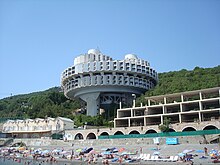sanatorium
Sanatorium (from Latin sanare , heal, heal ' , sanatorium ) usually referred to cure clinics or spas , but also psychiatric hospitals ; in the successor states of the Soviet Union a general spa or recreation facility .
history
An important reason for the historical wave of building sanatoriums, especially at the end of the 19th century, was the idea of healing. One aspired z. B. the healing of tuberculosis or alcoholism , but also of more obscure addictions and longings, of hysteria , masturbation and fatigue. It was a phenomenon of the heirs, wives and idlers of the wealthy upper class, which Thorstein Veblen described and analyzed in his famous classic of sociology, Theory of the Fine People , 1899. Those who could afford it followed this as well as other social fashions for which enterprising members of the bourgeoisie quickly provided the infrastructure.
At the beginning of the 20th century, for example, the following remedies were recommended: life reform , whey , Kneipp cures , drinking cures , enemas , walks, gymnastics , sun baths , water baths , nudism , fresh air and mountain air in general, to gardening and raw food .
The historical origin goes back further, only it was called differently back then. It is known of the Romans that they had a well-developed bathing culture. Budapest , the Hungarian capital, is known to go back to such a settlement around hot springs, which are believed to have medicinal properties. And in addition to his day job as experimental physics professor as a writer and aphorisms known Georg Christoph Lichtenberg wrote back in the 1780s , so in the late phase of the Age of Enlightenment , how to deal with air baths should promote overall health.
Soviet Union
In 1919 the communist leadership of the country passed a decree on health resorts / medicinal resources of national importance ; such were declared the property of the republic, placed under medical care and were intended to serve the healing treatment of the working people. In 1923 the first sanatoriums opened for government employees on the Crimean peninsula . First the facilities from the tsarist era were taken over, and new sanatoriums were not built until the early 1930s. The management of the Soviet spa system was transferred to the trade unions in 1933 ; thus social insurance paid for the workers' recreational costs.
The length of stay in a sanatorium ranged from 24 days to 10 months and was only possible after a doctor's referral. The recommendation contained information on the health resort, the type of sanatorium, the time of year, etc. Only then did you apply to the responsible trade union committee for a certificate of entitlement (“Putjevka”).
All sanatoriums specialized in the treatment of certain chronic illnesses and / or aftercare for convalescents; there were u. a. Mineral and mud baths and climatic health resorts that should be open all year round. An individual diet and healing plan was drawn up for each patient.
The facilities differed in the structure of the guests: adults, children, adolescents, parents with children, and in the operators of the spa system (the Central Council of the Communist Party, the Ministry of Health, other authorities and companies).
The prophylaxis clinics were a special form of sanatoria; they were mostly located in the vicinity of larger settlement and economic areas and were visited by people at risk of health during non-working hours.
administration
The certificates of eligibility for a spa stay were given to the unions by the Central Council for Spa , the amount was based on the previous year's information. The amount of the costs depended on the length of stay and the type of catering (treatments, number of residents per room, furniture, etc.), the stay was financed in part or in full by the unions and social security, and fare reductions were available for people in need intended.
In the case of medical care for children and adolescents, the state acted as the cost bearer, and there was often a combination of cure and school for longer stays. Each year around 10 million entitlement certificates were available for 140 million working people, which meant that there was only one certificate for every 14 applicants. The majority of the population often had to wait years for a certificate, which was mostly only valid for one person. The whereabouts and the season were not freely selectable.
In the large health resorts, union, community, company and children's sanatoriums were located next to each other. B. in Sochi on the Black Sea.
Before the Second World War there were a total of 94,700 spa places, in 1950 there were already 255,400 places available. In 1960 more than half of all sanatoriums were outside the 500 health resorts.
See also
literature
- Henningsen, Monika: The leisure and tourism in the former Soviet Union with special consideration of the Baltic area . 1993. Frankfurt.
- SW Kurasov et al. (Ed.): Spas of the USSR . 1962. Moscow.
- Moskoff, William: Labor and Leisure in the Soviet Union. The Conflict between Public and Private Decision-Making in a Planned Economy . 1984. Hong Kong.
- Thorstein Veblen: Theory of the Fine People. An economic study of institutions, Fischer Verlag, 1997, ISBN 978-3-596-27362-1




